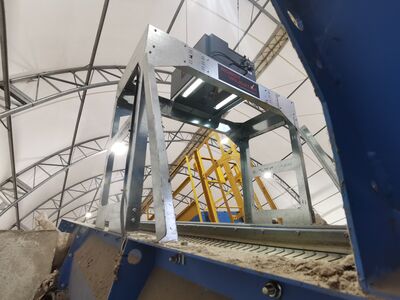Waste Robotics' Eric Camirand : "AI and digital tools will play a crucial role in optimising sorting processes"

Artificial intelligence is here to stay. Also in the waste management industry. The past few years have seen a surge in AI-powered waste management technology. Now Canadian sorting expert Waste Robotics has teamed up with AI specialist Greyparrot to provide intelligent sorting solutions. Waste Robotics is harnessing the power of Greyparrot's advanced AI waste analytics through the "Robot Validator." Waste Robotics' co-founder and CEO Eric Camirand talks with Waste Management World about this new partnership, the advantages of digital processes and the future of AI in the industry.
Related article: The Future of Recycling: Robots on the Rise
How did the partnership between Waste Robotics and Greyparrot come about?
Our partnership with Greyparrot was born out of the necessity to tackle the significant unknown and complexities associated with sorting robotics. These robotic arms, which can run into hundreds of thousands of dollars, represent substantial investments for waste facilities that are striving to extract more value from their materials. However, the lack of visibility into waste flow composition poses a challenge, making it hard for waste professionals to accurately forecast the return on these investments.
By integrating Greyparrot's advanced AI and computer vision systems with our robotic solutions, we provide waste facilities with detailed insights into waste composition and precisely identifying robotic sorting needs. This enhances sorting accuracy and gives waste professionals the data they need to make informed investment decisions.
Together, we are driving innovation and improving efficiency and sustainability in the industry.
What are the advantages for customers resulting from this partnership?
By integrating Greyparrot's AI waste recognition technology with our robotic sorting solutions, we provide detailed insights into waste composition. This data enables waste facilities to make informed investment decisions, ensuring they capture the maximum value from their materials. Having this data allows Waste Robotics to develop tailored robotic sorting solutions for specific needs and estimate the payback on their investments.
The tangible result is the optimisation of operations and a substantial increase in efficiency in material recovery, delivering real benefits to our customers.
You offer bespoke solutions. Why is this important?
Bespoke solutions are essential because waste management needs vary widely across different industries, regions, and waste types. A one-size-fits-all approach cannot address the unique challenges and objectives of each client. By offering customized solutions, we ensure that our technology and services align perfectly with the specific needs of each customer. This leads to better performance, higher satisfaction, and more sustainable waste management practices.
Related article: Innovative ideas for the waste management industry
For which waste streams does Waste Robotics offer solutions?
Waste Robotics offers solutions for a diverse range of waste streams, including municipal solid waste, construction and demolition waste, industrial waste, and electronic waste.
Our technology can handle various materials such as plastics, metals, paper, and organics, providing effective sorting capabilities across multiple sectors. This versatility allows us to address the specific needs of different industries and waste types.
What are the benefits of digitised processes compared to manual labor? Are there still processes that manual workers do better?
Digitised processes offer advantages over manual labour, including enhanced efficiency, accuracy, durability and consistency in sorting waste. Automated systems can operate continuously without fatigue, handle hazardous materials safely, and provide real-time data for process optimisation. However, manual workers excel in complex decision-making, adaptability, and oversight tasks.
Our goal is not to replace labour but to move workers to safer environments with the help of sorting robots. Human expertise remains crucial for managing systems and addressing unexpected challenges, ensuring a harmonious blend of technology and human skill.
Could you explain the concept of data-driven waste management technology and how it distinguishes itself from traditional waste management approaches?
Data-driven waste management technology leverages advanced sensors, AI, and data analytics to monitor and optimise waste sorting processes in real-time.
This approach provides a dynamic and adaptive solution, continuously improving through feedback and learning. Unlike traditional methods that rely heavily on manual sorting and static processes, data-driven technology offers precise monitoring, higher efficiency, and reduced environmental impact.
Our phased approach ensures that solutions are tailored to each client's specific needs, enhancing overall effectiveness.
What are the challenges associated with managing and analysing the large volumes of data generated by data-driven waste management systems?
Managing and analysing large volumes of data involves challenges such as ensuring data accuracy, integrating data from various sources, and maintaining data security.
Robust infrastructure and advanced analytical tools are necessary to process and interpret the data effectively. Additionally, deriving actionable insights from the data can be complex, requiring skilled personnel who understand both the technology and the waste management industry.
What type of waste poses the greatest challenge to data-driven technology?
Mixed and contaminated waste streams pose the greatest challenge to data-driven technology.
Differentiating between materials with similar appearances or properties, especially when contaminants are present, can be difficult. Advanced AI and machine learning algorithms are continually being developed to enhance the identification and sorting of such complex waste, but it remains an area of ongoing innovation.

Is the industry willing to adapt to new technologies?
The industry is increasingly willing to adapt to new technologies as the benefits become more evident.Environmental regulations, the push for sustainability, and the economic advantages of improved efficiency drive adoption. However, resistance can still occur due to the initial investment required and the need for change management. Demonstrating clear ROI and providing support during the transition are key to facilitating adoption.
Will we see more digitalisation and AI in recycling technology in the future?
Yes, the future will undoubtedly see more digitalisation and AI in recycling technology.
The drive for greater efficiency, sustainability, and the circular economy will continue to push technological advancements.
AI and digital tools will play a crucial role in optimizing sorting processes, reducing waste, and providing valuable insights for continuous improvement in recycling operations.
Where do you see the biggest market growth?
The biggest market growth is likely to occur in regions with stringent environmental regulations and strong sustainability initiatives. Additionally, sectors that generate significant volumes of waste, such as manufacturing, construction, and consumer goods, are poised for substantial growth as they seek to improve their waste management practices.
Emerging markets are also becoming increasingly aware of the benefits of advanced waste management technologies, presenting new opportunities for expansion.



